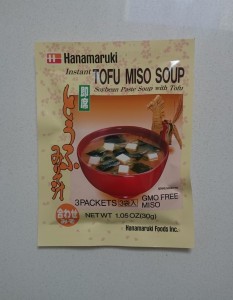
Picture: White miso paste is a great ingredient to keep at the back of your fridge!
Miso is a seasoning made from fermented soybeans, salt, and a fungus known as kouji. The result is a versatile thick paste that can be used for a million and one things! Most commonly known of course is miso soup, served with almost every set meal in Japan. The soybeans are a valuable source of protein, and the fermenting process adds additional vitamins and minerals for an all-round nutritional food. Although uncommon now, in feudal Japan many households made their own miso, so it was quite varied between different regions of Japan. Now it is mass produced and pretty universal in terms of how it’s made and its flavour.
Tokyo Mari has a great master recipe for miso paste if you’re interested in trying your hand at making some at home, but if not, you can buy both red and white miso paste in most Asian grocers, and you might be able to find it in major supermarkets depending on where you live. By the way, what’s the difference between red and white miso?
Picture: Instant miso soup is available in most supermarkets and asian grocers
Along with the three ingredients listed above, white miso is fermented with rice, resulting in a light colour and a sweeter taste. The sweetness means it can be used in condiments like mayonnaise or salad dressings. Red miso, on the other hand, is fermented with barley with a high percentage of soybeans and is fermented for longer. As a general rule, the longer the paste is fermented, the darker the colour. There’s even a ‘black’ miso! You can mix red and white miso together to make awase miso, too. In the Kanto Region (Tokyo) red miso is preferred, while in the Kansai Region (Kyoto, Osaka) white is more common.
Having a stash of miso paste in your fridge means you can whip up healthy, quick meals in no time. You can marinate vegetables in the paste in grill them (eggplant is particularly good for this!). Corn on the cob can be brushed lightly with miso paste for a salty zing. Yakimochi is plain mochi coated in miso paste and grilled. A way to spice up your miso paste is to add it to butter.
Miso butter mixes the saltiness of the miso with the creaminess of butter for a delicious result. Here’s a recipe for Miso Butter Salmon:
Picture: fresh salmon from the Sydney Fish Markets
Ingredients:
1 Tbsp butter
1/2 Tbsp white miso paste
2 fillets salmon (we sourced our salmon from Decosti at the Sydney Fish Markets)
Pinch of salt
1 inch of ginger, minced
1/3 cup fried tofu, sliced
1 cup rice
1 Tbsp sesame oil
1 eggplant, cut how you like
Method:
Picture: Salmon frying in miso butter
Add miso soup for a full course Japanese meal!